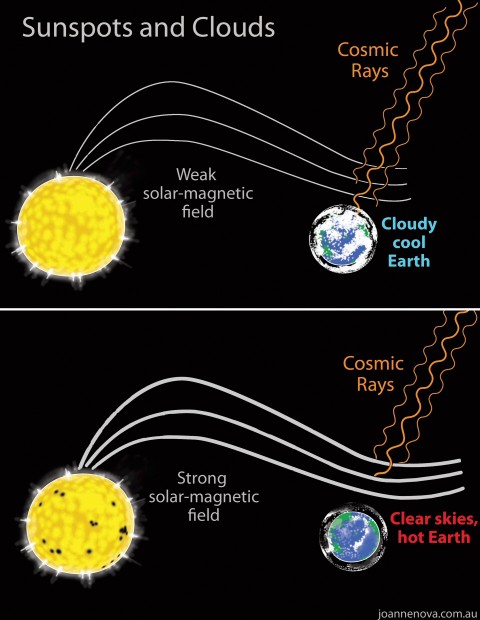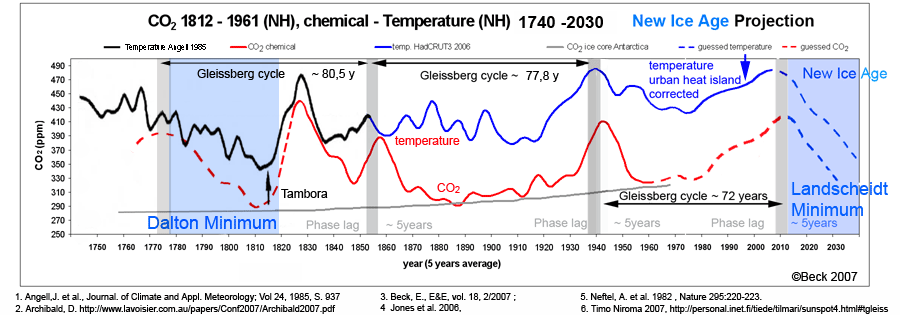5.1.3 Ursache der neuen Kälteperiode
en Cause of the new cold period
fr La cause d'une nouvelle periode froide
- 1 de
Gründe des Stillstands der globalen Erwärmung
en Cause of 'the pause' in global warming
fr Cause de l'arrêt du réchauffement - 2 de
Der Einfluss der Sonne auf das Klima
en The influence of the sun on the climate
fr L'influence du soleil sur le climat - 3 de
Klima in der Zukunft
en Climate in the future
fr Climat au futur
|
Oh. I always though the main controller of climate was number of mobile telephone calls per annum, since the correlation between temperature and phone use (nay, TV's if we include the 1930's - present) has increased since temperatures began to rise as a correlation to the use of these instruments' increase. Since the ghg's are an unreliable source of climate forcing, particlarly CO2, due to its peripheral-non-existent magnitude on the climate, then by a process of elimination, it MUST be the correlation between temperature and increasing use of TV's and phones. I'm working on a model that will conclusively and indisputably show that the sharp increase in the numbers of crooked politicians and activist scientists is unequivocally responsible for the earth warming :).
|
||
|
The first step should be to demonstrate that the models can predict the past climate of the earth. What would be interesting, for example, would be to see a climate model which can prove or disprove the existence of the MWP and explain its cause, or lack of existence. (If anyone knows of such a model validation, please let me know). |
Using climate models which have been tuned for high sensitivity to carbon dioxide, it has been found that climate models have a high sensitivity to carbon dioxide. That's SCIENCE! Boy, is the sun going to be disappointed, all this time it thought it had the most input. Plants and oceans "condense" CO2 constantly and abundantly. What planet are these guys on? Not more climate model evidence. These people have just proved that they are not scientists.
It is truly amazing how "reputable" journals accept from some
few selected fellows their trivial hypothesis and publish as a
scientific paper. One word applies: Garbage |
⇧
1 Gründe des Stillstands der globalen Erwärmung
en Cause of 'the pause' in global warming
fr Cause de l'arrêt du réchauffement
-
EIKE Europäisches Institut für Klima und Energie
Don J. Easterbrook, Dept of Geology, Western Washington University
2014-01-19 de Die Gründe des Stillstands der globalen Erwärmung sind seit langem klar*
-
Watts Up With That? (Antony Watts)
Don J. Easterbrook, Dept of Geology, Western Washington University
2014-01-17 en Cause of 'the pause' in global warming
⇧
2 Der Einfluss der Sonne auf das Klima
en The influence of the sun on the climate
fr L'influence du soleil sur le climat
| de | en | fr |
|---|---|---|
| Ursachen des Klimawandels | Causes of Climate Change | Les causes du changement climatique |
| Der Einfluss der Sonne auf das Klima | The influence of the sun | L'influence du soleil |
|
de Die Sonnenaktivität steuert die Kosmischen Strahlen und dadurch die Wolkenbildung. Mehr Sonnenaktivität → weniger Wolken → es wird wärmer. en The sun is influencing the cosmic rays and therefore the clouds cover. More solar activity → less clouds → warmer Earth. fr Le Soleil influence les rayons cosmiques est par cela les nuages sur la terre. Augmentation de l'activité solaire → moins de nuages → réchauffement de la terre. |
de Mehr Sonnenaktivität → weniger Wolken → es wird wärmer.
-
Bei grosser Sonnenaktivität erreicht weniger Kosmische Strahlung die Erde.
-
Mit weniger Kosmischer Strahlung werden weniger Wolken auf der Erde gebildet.
-
Weniger Wolken lassen mehr Sonnenstrahlung auf die Erde, womit sich die Erde erwärmt.
de Mehr Sonnenaktivität → weniger Wolken → es wird wärmer.
Bei grosser Sonnenaktivität erreicht weniger Kosmische Strahlung die Erde.
Mit weniger Kosmischer Strahlung werden weniger Wolken auf der Erde gebildet.
Weniger Wolken lassen mehr Sonnenstrahlung auf die Erde, womit sich die Erde erwärmt.
en More solar activity → less clouds → warmer Earth.
A stronger wind from greater solar activity will reduce the flux of cosmic ray reaching Earth.
Less cosmic rays means less cloud cover on the earth.
Less cloud cover influences the terrestrial climate by higher solar radiation.
fr Augmentation de l'activité solaire → moins de nuages → réchauffement de la terre.
Une augmentation de l'activité solaire a comme effet une réduction du flux de rayons cosmiques atteignant la terre.
Moins de rayons cosmiques produisent moins de nuages sur la terre.
Moins de nuages laissent plus de rayons solaires réchauffer la terre.
|
|
de Seit längerem kursiert die Hypothese von Henrik Svensmark, nach der die sich Galaktische Kosmische Strahlung (Galactic Cosmic Rays, GCR), die von dem sich verändernden Sonnenmagnetfeld mehr oder weniger stark von der Erde ferngehalten wird, die Wolkenbildung in der Erdatmosphäre und damit das Klima beeinflußt. en I've reported several times at WUWT on the galactic cosmic ray theory proposed by Henrik Svensmark which suggests that changes in the sun's magnetic field modulate the density of Galactic Cosmic Rays (GCRs) which in turn seed cloud formation on Earth, which changes the albedo/reflectivity to affect Earth's energy balance and hence global climate. |
|
|
|
|
de Die Klimaänderungen werden von der Sonne verursacht.
-
Der Mechanismus ist nicht ganz einfach zu erklären.
Es ist nicht die Variation der Abstrahlung der Sonne massgebend, sondern die von der Sonne mit dem Sonnenwind abgelenkten kosmischen Strahlen, die die Bildung von Wolken beeinflussen, womit weniger oder mehr Sonnenstrahlung auf die Erde auftrifft.
Bei grosser Sonnenaktivität entsteht mehr Sonnenwind, der die kosmischen Strahlen von der Erde ablenkt. Dadurch werden weniger Wolken gebildet und es treffen mehr Sonnenstrahlen auf die Erde auf.
Die entsprechenden Forschungsarbeiten sind relativ neu.
- Wasserplanet de Sonnenwind und kosmische Strahlung
en Cosmic Rays and Climate
-
ScienceBits / Nir J. Shaviv
en Cosmic Rays and Climate
-
en Chapter 6 Radiative Forcing of Climate Change
6.11.2.2 Cosmic rays and cloudsClimate Change 2001 IPCC Working Group I: The Scientific Basis
Svensmark and Friis-Christensen (1997) demonstrated a high degree of correlation between total cloud cover, from the ISCCP C2 data set, and cosmic ray flux between 1984 and 1991.
Changes in the heliosphere arising from fluctuations in the Sun's magnetic field mean that galactic cosmic rays (GCRs) are less able to reach the Earth when the Sun is more active so the cosmic ray flux is inversely related to solar activity.
Svensmark and Friis-Christensen analysed monthly mean data of total cloud using only data over the oceans between 60°S and 60°N from geostationary satellites.
They found an increase in cloudiness of 3 to 4% from solar maximum to minimum and speculated that (a) increased GCR flux causes an increase in total cloud and that (b) the increase in total cloud causes a cooling of climate.
Svensmark and Friis-Christensen (1997) also extended this analysis to cover the years 1980 to 1996 using cloud data from the DMSP and Nimbus-7 satellites and showed that the high correlation with GCR flux is maintained
But IPCC concluded:
We conclude ... At present there is insufficient evidence to confirm that cloud cover responds to solar variability.Remarks:
IPCC has not reconsidered its position yet. (2015)
| Henrik Svensmark |
Prof. Dr., Director of Sun-Climate Research at the Danish National
Space Center
▶Henrik Svensmark: Who is who (Skeptiker) ▶Henrik Svensmark: Video (Präsentationen) |
- ScienceBits / Nir J. Shaviv en The Milky Way Galaxy's Spiral Arms and Ice-Age Epochs and the Cosmic Ray Connection
- john-daly.com en Global Warming - from the Sun
-
en
Here is how what is known as the Cosmic Theory works
Canada Free Press / Dr. Tim Ball
2009-04-06 en C02 Global Warming's IPCC-created Hobglobin
-
Watts Up With That? (Antony Watts)
2009-04-15 en The oceans as a calorimeter and solar amplification
fr Lien entre les rayons cosmiques, l'activité solaire et le climat terrestre.
-
L'activité solaire changeante est responsable de la variation de la
force du vent solaire.
Un vent plus fort réduira le flux de rayons cosmiques atteignant la Terre, car ils perdent plus d'énergie en traversant le système solaire.
Les rayons cosmiques viennent d'au-delà du système solaire (les rayons cosmiques en dessous de 1015 eV sont probablement accélérés par les restes de super-novas).
Alors que les rayons cosmiques dominent l'ionisation de la troposphère, une activité solaire en augmentation se traduit par une ionisation réduite et empiriquement (comme montré ci-dessous), également à une réduction de la couverture nuageuse à basse altitude. Alors que les nuages de basse altitude ont un net effet de refroidissement (leur "blancheur" est plus importante que leur effet "couverture"), l'activité solaire augmentée signifie un climat plus chaud.
Les variations intrinsèques du flux de rayons cosmiques peuvent avoir un effet similaire, pour une fois, non-reliées à l'activité solaire.
Henrik Svensmark du Danish National Space Center à Copenhague a montré que la couverture nuageuse varie de manière synchrone avec le flux variable de rayons cosmiques atteignant la Terre.
A l'échelle de temps adéquate, les plus grandes variations se produisent suivant le cycle solaire de 11 ans et en fait, cette couverture semble suivre le cycle et la moitié de l'amplitude du flux de rayons cosmiques.
- Skyfall/Changement climatique fr Rayons cosmiques et climat
-
Pensée unique (Jean Martin)
fr La thèse dominante de ceux qui ne croient pas à l'effet de serre dû au CO2 rejeté par l'homme
⇧
3 Klima in der Zukunft
en Climate in the future
fr Climat au futur
-
en Die Periode der Globalen Erwärmung ist beendet - eine neue Kälteperiode hat begonnen
-
en Global Warming has ended - The Next Climate Change to a pronounced Cold Era has begun
It is time that the world community acknowledges that the Earth has begun its next climate change.
The Space and Science Research Center (SSRC), today declares that the world's climate warming of the past decades has now come to an end.
A new climate era has already started that is bringing predominantly colder global temperatures for many years into the future.
In some years this new climate will create dangerously cold weather with significant ill-effects world wide.
Global warming is over - a new cold climate has begun.
- fr Le réchauffement climatique est terminé - Le temps se mettra au froid
-
Space and Science Research Center - Press Releases
2008-07-01 en Global Warming Has Ended - The Next Climate Change to A Pronounced Cold Era Has Begun
-
Watts Up With That? (Antony Watts)
2008-07-12 en Global Warming Out, Global Cooling In
-
CFP Canada Free Presss/Dr. Tim Ball
2008-07-22 en Gore getting desperate proof public cooling on GW hoax
- Pensée unique (Jean Martin) fr Préparons nous au refroidissement!
-
Skyfall / Changement Climatique
2007-06-03 fr Le refroidissement global est en cours !
|
|
|
|---|





